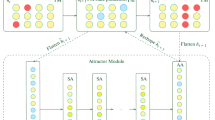Abstract
Artificial intelligence systems operating in the sequential decision making paradigm are inevitably required to do effective spatio-temporal processing. The memory models for such systems are often required not just to memorize the observed data stream, but also to encode it so it is possible to separate dissimilar sequences and consolidate similar ones. Moreover, for solving complex problems, it is advantageous to have the ability to treat sequences as unit abstractions, which imposes restrictions on the topology of the representation space and the information contained in the representations themselves. In this paper, we propose a method for encoding sequences that allows efficient memorization, but at the same time retains the degree of similarity between sequences. We based our approach on the combination of biologically-inspired temporal memory and spatial attractor that stabilize temporal coding. The experiments performed on synthetic data confirm the coding efficiency and allow us to identify promising directions for further development of methods.
Access this chapter
Tax calculation will be finalised at checkout
Purchases are for personal use only
Similar content being viewed by others
References
Ba, J., Hinton, G.E., Mnih, V., Leibo, J.Z., Ionescu, C.: Using fast weights to attend to the recent past. In: Lee, D., Sugiyama, M., Luxburg, U., Guyon, I., Garnett, R. (eds.) Advances in Neural Information Processing Systems, vol. 29. Curran Associates, Inc. (2016)
Barak, O., Tsodyks, M.: Working models of working memory. Curr. Opin. Neurobiol. 25, 20–24 (2014). theoretical and computational neuroscience
Bessonov, A., Staroverov, A., Zhang, H., Kovalev, A.K., Yudin, D., Panov, A.I.: Recurrent memory decision transformer. arXiv preprint arXiv:2306.09459 (2023)
Botvinick, M.M., Plaut, D.C.: Short-term memory for serial order: a recurrent neural network model. Psychol. Rev. 113(2), 201 (2006)
Burtsev, M.S., Kuratov, Y., Peganov, A., Sapunov, G.V.: Memory transformer. arXiv preprint arXiv:2006.11527 (2020)
Cho, K., et al.: Learning phrase representations using RNN encoder-decoder for statistical machine translation. arXiv preprint arXiv:1406.1078 (2014)
Dai, Z., Yang, Z., Yang, Y., Carbonell, J., Le, Q.V., Salakhutdinov, R.: Transformer-xl: attentive language models beyond a fixed-length context. arXiv preprint arXiv:1901.02860 (2019)
Dedieu, A., Gothoskar, N., Swingle, S., Lehrach, W., Lázaro-Gredilla, M., George, D.: Learning higher-order sequential structure with cloned HMMs (2019)
Dzhivelikian, E., Latyshev, A., Kuderov, P., Panov, A.I.: Hierarchical intrinsically motivated agent planning behavior with dreaming in grid environments. Brain Inform. 9(1), 8 (2022)
Graham, D., Field, D.: Sparse coding in the neocortex. Evol. Nerv. Syst. 3 (2007). https://doi.org/10.1016/B0-12-370878-8/00064-1
Hawkins, J., Ahmad, S., Cui, Y.: A theory of how columns in the neocortex enable learning the structure of the world. Front. Neural Circuits 11, 81 (2017). https://doi.org/10.3389/fncir.2017.00081
Heeger, D.J.: Theory of cortical function. Proc. Natl. Acad. Sci. 114(8), 1773–1782 (2017). https://doi.org/10.1073/pnas.1619788114
Himberger, K.D., Chien, H.Y., Honey, C.J.: Principles of temporal processing across the cortical hierarchy. Neuroscience 389, 161–174 (2018). 8
Hochreiter, S., Schmidhuber, J.: Long short-term memory. Neural Comput. 9, 1735–80 (1997). https://doi.org/10.1162/neco.1997.9.8.1735
Jaegle, A., Gimeno, F., Brock, A., Vinyals, O., Zisserman, A., Carreira, J.: Perceiver: general perception with iterative attention. In: International Conference on Machine Learning, pp. 4651–4664. PMLR (2021)
Kuderov, P., Panov, A.: Planning with hierarchical temporal memory for deterministic Markov decision problem. In: Rocha, A.P., Steels, L., Herik, J.V.D. (eds.) Proceedings of the 13th International Conference on Agents and Artificial Intelligence, vol. 2, pp. 1073–1081. SCITEPRESS - Science and Technology Publications (2021). https://doi.org/10.5220/0010317710731081
Miconi, T.: Biologically plausible learning in recurrent neural networks reproduces neural dynamics observed during cognitive tasks. Elife 6, e20899 (2017)
Oster, M., Douglas, R., Liu, S.C.: Computation with spikes in a winner-take-all network. Neural Comput. 21(9), 2437–2465 (2009)
Rolls, E.T., Mills, W.P.C.: Computations in the deep vs superficial layers of the cerebral cortex. Neurobiol. Learn. Mem. 145, 205–221 (2017)
Rumelhart, D.E., Hinton, G.E., Williams, R.J.: Learning internal representations by error propagation. Technical report, California Univ San Diego La Jolla Inst for Cognitive Science (1985)
Smith, S.L., Smith, I.T., Branco, T., Häusser, M.: Dendritic spikes enhance stimulus selectivity in cortical neurons in vivo. Nature 503(7474), 115–120 (2013). https://doi.org/10.1038/nature12600
Staiger, J.F., Petersen, C.C.H.: Neuronal circuits in barrel cortex for whisker sensory perception. Physiol. Rev. 101(1), 353–415 (2021). https://doi.org/10.1152/physrev.00019.2019
Stuart, G.J., Spruston, N.: Dendritic integration: 60 years of progress. Nat. Neurosci. 18(12), 1713–1721 (2015). https://doi.org/10.1038/nn.4157
Vaswani, A., et al.: Attention is all you need. Adv. Neural Inf. Process. Syst. 30 (2017)
Whittington, J.C., et al.: The Tolman-Eichenbaum machine: unifying space and relational memory through generalization in the hippocampal formation. Cell 183(5), 1249-1263.e23 (2020)
Yu, Y., Si, X., Hu, C., Zhang, J.: A review of recurrent neural networks: LSTM cells and network architectures. Neural Comput. 31(7), 1235–1270 (2019)
Author information
Authors and Affiliations
Corresponding author
Editor information
Editors and Affiliations
Rights and permissions
Copyright information
© 2023 The Author(s), under exclusive license to Springer Nature Switzerland AG
About this paper
Cite this paper
Kuderov, P., Dzhivelikian, E., Panov, A.I. (2023). Stabilize Sequential Data Representation via Attraction Module. In: Liu, F., Zhang, Y., Kuai, H., Stephen, E.P., Wang, H. (eds) Brain Informatics. BI 2023. Lecture Notes in Computer Science(), vol 13974. Springer, Cham. https://doi.org/10.1007/978-3-031-43075-6_8
Download citation
DOI: https://doi.org/10.1007/978-3-031-43075-6_8
Published:
Publisher Name: Springer, Cham
Print ISBN: 978-3-031-43074-9
Online ISBN: 978-3-031-43075-6
eBook Packages: Computer ScienceComputer Science (R0)




